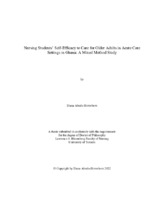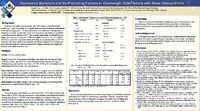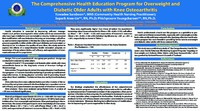| dc.contributor.author | Lee, Fung-kam Iris | en |
| dc.contributor.author | Lee, Diana T. F. | en |
| dc.contributor.author | So, Winnie Kwok Wai | en |
| dc.date.accessioned | 2014-11-17T13:45:03Z | |
| dc.date.available | 2014-11-17T13:45:03Z | |
| dc.date.issued | 2014-11-17 | |
| dc.identifier | INRC14F03 | |
| dc.identifier.uri | http://hdl.handle.net/10755/335131 | |
| dc.description | <p>International Nursing Research Congress, 2014 Theme: Engaging Colleagues: Improving Global Health Outcomes. Held at the Hong Kong Convention and Exhibition Centre, Wanchai, Hong Kong</p> | en |
| dc.description.abstract | <p>Session presented on Saturday, July 26, 2014:</p>
<p>Purpose: Knee osteoarthritis (KOA) is a common health problem in the older population (Gabriel & Michaud, 2009). Exercise has been recommended as the first-line clinical management strategy (Zhang et al., 2008) and its effectiveness has been well documented (Bosomworth, 2009; Scott & Kowalczyk, 2007; Zhang et al., 2008). However, exercise adherence is questionable and thus affecting the effectiveness of the recommended therapeutic exercise (Ettinger et al., 1997; Pisters et al., 2007). Previous literature indicates that a client-centered exercise intervention may improve exercise adherence of older people with KOA (Campbell et al., 2001). To promote therapeutic exercise adherence, a cultural and contextual-specific exercise program was developed for older people with KOA in Hong Kong (Lee, 2011). This exercise program was developed with reference to the findings of a qualitative study which explored the experience and perceptions of exercise in a group of older people with knee osteoarthritis (KOA), a comprehensive review of previous scientific evidence on exercise intervention in older people with KOA, and in consultation with a group of multidisciplinary healthcare experts (i.e. medical officer, traditional Chinese practitioner, sports scientist, physiotherapists, geriatric nurse, and social worker). The purposes of this study were to evaluate the effectiveness of a cultural and contextual-specific exercise program in promoting therapeutic exercise adherence among older people with KOA and to explore the participants' perceptions and experiences of participating in the exercise program. Methods: The objectives of the study were: To evaluate the participants' exercise adherence. To evaluate the participants' level of mastering of the recommended exercise movements. To assess the participants' satisfaction with the exercise program. To explore the participants' perceptions towards the design and content of the exercise program. To explore the participants' experiences of practicing and integrating the exercise in daily living. Design and subjects: This study used a mixed-methods design which was a single group quantitative study followed by an exploratory qualitative study. The subjects of this study were recruited from a community center for older people and the final sample consisted of 33 older Chinese people with KOA dwelling in the community. Among the 33 older people who had completed the quantitative study, 6 of them with different levels of satisfaction and exercise adherence were selected for individual face-to-face semi-structured interviews. Study instruments: An exercise diary was used to evaluate the participants' exercise adherence. A skill assessment checklist was used to evaluate the participants' level of mastering of the recommended exercise movements. In addition, participants' satisfaction with the exercise program was also assessed by a self-developed questionnaire. A semi-structured interview guide was employed in the qualitative phase of the study. Example of questions asked are: "What is your view about the exercise program?" and "What is your experience of integrating the recommended exercise into daily living?". Data collection procedures: The participants were asked to give individual written consent. The exercise program provided to the participants consisted of four one-hour weekly sessions. It was delivered by using a small group (N = 8-10) approach. On completion of the exercise program, the participants were individually interviewed for filling out the satisfaction questionnaire. They were also given a diary and a chop to mark down their practice of the recommended exercise movements for a period of 12 weeks. At 12 weeks after the exercise program, the participants were invited to an individual return-demonstration session to demonstrate their level of skills in mastering the recommended exercise movements. Six participants, who gave their written consent for an individual face-to-face semi-structured interview, were interviewed after the return-demonstration session. Results: The quantitative results showed that the participants were highly adhered to the recommended exercise regimen (mean percentage = 91.04%; SD = 14.54) in a 12 weeks period. Their overall performance in mastering of the exercise movements was good (mean score = 76.71/100; SD = 21.75). The participants also demonstrated a high satisfaction level with the exercise program (mean score = 90.15/100; SD = 8.05). The qualitative findings revealed four major categories: satisfaction with the exercise program, mastering of the exercise movements, experience of the exercise's effects, and integration of the exercises into the daily routine. These findings were consistent with the quantitative results of the study. Conclusion: The quantitative and qualitative findings of this study were consistent and complementary, showing that the exercise program was well accepted by the older Chinese people with KOA in terms of satisfaction with the exercise program, adherence to the exercise regimen, and mastering of the exercise movements. The findings of this study provide evidence to support the need to take into consideration of clients' cultural and contextual environment in the development of exercise program in order to promote clients' adherence to the therapeutic exercise regimen. However, the 12 weeks follow up period in this study has limitations to the understanding of the long-term effect of the exercise program. Future studies should consider a longer follow up period such as 5 years (Pisters et al., 2010). Exercise adherence is fundamental for effective exercise intervention, client-centered approach in development of exercise intervention should be considered a way forward in order to promote exercise adherence among clients with chronic diseases.</p> | en |
| dc.language.iso | en | en |
| dc.subject | Exercise Adherence | en |
| dc.subject | Knee Osteoarthritis | en |
| dc.subject | Older Adults | en |
| dc.title | A mixed-methods study for evaluating the effect of a cultural and contextual-specific exercise program on therapeutic exercise adherence of older people with knee osteoarthritis | en |
| dc.title.alternative | Geriatric Nursing Research | en |
| dc.type | Presentation | en |
| dc.rights.holder | <p>
All rights reserved by the author(s) and/or publisher(s) listed in this item record unless relinquished in whole or part by a rights notation or a Creative Commons License present in this item record.
</p><p>
All permission requests should be directed accordingly and not to the Sigma Repository.
</p><p>
All submitting authors or publishers have affirmed that when using material in their work where they do not own copyright, they have obtained permission of the copyright holder prior to submission and the rights holder has been acknowledged as necessary.
</p> | en |
| dc.description.note | <p>Items submitted to a conference/event were evaluated/peer-reviewed at the time of abstract submission to the event. No other peer-review was provided prior to submission to the Henderson Repository.</p> | |
| dc.type.category | Full-text | en |
| dc.evidence.level | N/A | en |
| dc.research.approach | N/A | en |
| dc.contributor.department | Non-member | en |
| dc.author.details | Fung-kam Iris Lee, PhD, RN; Diana T. F. Lee, PhD, MSc, PRD (HCE), RM, RN, RTN; Winnie Kwok Wai So, PhD, RN | en |
| dc.conference.name | 25th International Nursing Research Congress | en |
| dc.conference.host | Sigma Theta Tau International | en |
| dc.conference.location | Hong Kong | en |
| dc.date.conferenceyear | 2014 | |
| dc.contributor.affiliation | The Chinese University of Hong Kong, Shatin, Hong Kong | en |
| dc.description.reviewtype | Abstract Review Only: Reviewed by Event Host | en |
| dc.description.acquisition | Proxy-submission | en |





